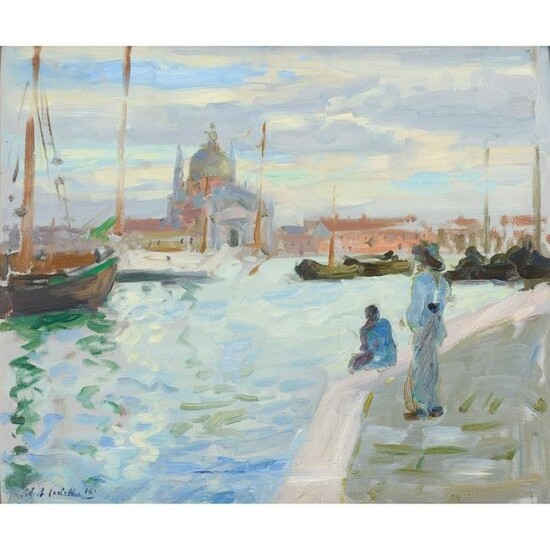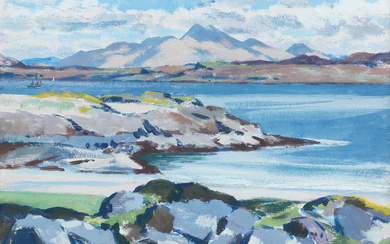â—† FRANCIS CAMPBELL BOILEAU CADELL R.S.A., R.S.W.
â—† FRANCIS CAMPBELL BOILEAU CADELL R.S.A., R.S.W. (SCOTTISH 1883-1937) THE GIUDECCA AND REDENTORE, VENICE Signed and dated '10, inscribed on the backboard verso, oil on board (37cm x 44.5cm (14.5in x 17.5in)) Provenance: Acquired from the Artist by Sir Patrick Ford and thence by descent when purchased by the current owner Footnote: Note: The Giudecca and Redentore, Venice comes from a beautiful series of works which marked Cadell's emergence as one of the most important Scottish artists of the twentieth-century. Cadell trained at the Académie Julian in Paris and at the Akademie der Bildenden Künste in Munich. He had his first solo exhibition in Edinburgh in 1908, which garnered twenty-five sales including to his school friend and future politician Patrick Ford. The following year, Cadell established a studio in George Street, in the heart of Edinburgh's New Town. In 1910, Cadell received a cheque from Ford 'to go to Venice and paint. He to choose equivalent in pictures on return £150' (as recorded by the artist in his Register of Pictures and quoted in Alice Strang, F. C. B. Cadell, Edinburgh 2011, p. 17). It is no wonder that Cadell was attracted to Venice. Its romanticised reputation as an artistic mecca had been cemented in the nineteenth-century, with Lord Byron’s dramatic poetry and J. M. W. Turner’s evocative representations inspiring a generation of artists, each keen to depict the city’s unique vistas. Despite the explosion of tourist activity, Venice never became passé among artists. Manet and Whistler were drawn there, excited by the challenge of creating their own interpretations of lauded Venetian motifs. Though Monet resisted visiting until 1908, he too was stimulated by the beautiful architecture and mercurial light of the Lagoon and produced a series of atmospheric paintings which received wide critical approval upon their exhibition. The bright Mediterranean light shimmering off the canals had a marked effect on Cadell's palette, into which he introduced a much more vibrant colour range. Though it is highly unlikely that he saw Monet’s Venetian cityscapes at first hand, the tonal similarities of their work inspired by the city is striking; both artists punctuating the whites and creams of the sun-drenched architecture with pinks, purples and turquoises. Cadell’s technique became looser and more expressive than ever before. Bold, loaded brushstrokes were layered to convey the rippling surface of the waterways and fleeting impressions of passers-by. He revelled in the beautiful scenes by which he found himself surrounded and painted views as varied as that of a bustling St Mark’s Square to quieter, more contemplative corners of the city and its inhabitants. The present work depicts one of Venice's most celebrated views. Against a backdrop of a vividly-realised sky, Cadell describes the distinctive outline of the Redentore, the Church of the Most Holy Redeemer and its architectural neighbours. He conveys reflected light with swift, delicate lilac flicks of his paint brush. As we lower our eyes and let them drift across the rippling waves of the Giudecca Canal, we meet the thoughtful figures at the water's edge. The surface of the painting is enlivened with rhythmic, distinct brushstrokes, with paint quickly applied 'wet on wet', giving a sense of the speed and confidence with which Cadell worked. The results of Cadell's successful and productive trip were exhibited at The Scottish Gallery in Edinburgh in 1912 and proved to be a watershed in his burgeoning career. Ford selected six from the series for his collection, including The Giudecca and Redentore, Venice, which remained in his family for generations. Three further Venetian paintings were presented in Ford's honour to the National Galleries of Scotland in 2014.
[ translate ]Sale price
Estimate
Time, Location
Auction House
â—† FRANCIS CAMPBELL BOILEAU CADELL R.S.A., R.S.W. (SCOTTISH 1883-1937) THE GIUDECCA AND REDENTORE, VENICE Signed and dated '10, inscribed on the backboard verso, oil on board (37cm x 44.5cm (14.5in x 17.5in)) Provenance: Acquired from the Artist by Sir Patrick Ford and thence by descent when purchased by the current owner Footnote: Note: The Giudecca and Redentore, Venice comes from a beautiful series of works which marked Cadell's emergence as one of the most important Scottish artists of the twentieth-century. Cadell trained at the Académie Julian in Paris and at the Akademie der Bildenden Künste in Munich. He had his first solo exhibition in Edinburgh in 1908, which garnered twenty-five sales including to his school friend and future politician Patrick Ford. The following year, Cadell established a studio in George Street, in the heart of Edinburgh's New Town. In 1910, Cadell received a cheque from Ford 'to go to Venice and paint. He to choose equivalent in pictures on return £150' (as recorded by the artist in his Register of Pictures and quoted in Alice Strang, F. C. B. Cadell, Edinburgh 2011, p. 17). It is no wonder that Cadell was attracted to Venice. Its romanticised reputation as an artistic mecca had been cemented in the nineteenth-century, with Lord Byron’s dramatic poetry and J. M. W. Turner’s evocative representations inspiring a generation of artists, each keen to depict the city’s unique vistas. Despite the explosion of tourist activity, Venice never became passé among artists. Manet and Whistler were drawn there, excited by the challenge of creating their own interpretations of lauded Venetian motifs. Though Monet resisted visiting until 1908, he too was stimulated by the beautiful architecture and mercurial light of the Lagoon and produced a series of atmospheric paintings which received wide critical approval upon their exhibition. The bright Mediterranean light shimmering off the canals had a marked effect on Cadell's palette, into which he introduced a much more vibrant colour range. Though it is highly unlikely that he saw Monet’s Venetian cityscapes at first hand, the tonal similarities of their work inspired by the city is striking; both artists punctuating the whites and creams of the sun-drenched architecture with pinks, purples and turquoises. Cadell’s technique became looser and more expressive than ever before. Bold, loaded brushstrokes were layered to convey the rippling surface of the waterways and fleeting impressions of passers-by. He revelled in the beautiful scenes by which he found himself surrounded and painted views as varied as that of a bustling St Mark’s Square to quieter, more contemplative corners of the city and its inhabitants. The present work depicts one of Venice's most celebrated views. Against a backdrop of a vividly-realised sky, Cadell describes the distinctive outline of the Redentore, the Church of the Most Holy Redeemer and its architectural neighbours. He conveys reflected light with swift, delicate lilac flicks of his paint brush. As we lower our eyes and let them drift across the rippling waves of the Giudecca Canal, we meet the thoughtful figures at the water's edge. The surface of the painting is enlivened with rhythmic, distinct brushstrokes, with paint quickly applied 'wet on wet', giving a sense of the speed and confidence with which Cadell worked. The results of Cadell's successful and productive trip were exhibited at The Scottish Gallery in Edinburgh in 1912 and proved to be a watershed in his burgeoning career. Ford selected six from the series for his collection, including The Giudecca and Redentore, Venice, which remained in his family for generations. Three further Venetian paintings were presented in Ford's honour to the National Galleries of Scotland in 2014.
[ translate ]



